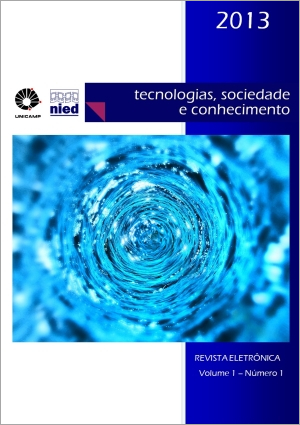Abstract
A general methodology is proposed along with a process model for conducting learning sessions, considering a collaborative environment with synchronous interaction, mediated by digital tools. We observe that it is not enough to make digital tools available to teachers and learners when the aim is to include technology in education. A lack of methodologies has been identified for guiding the creation of new forms of instructional design, based on the interaction through digital tools. Furthermore, it was observed that most learning platforms exploits only asynchronous interactions. Thus, after identifying tools that allow real-time social interaction approaches, we propose a set of phases, steps and activity patterns that guide the implementation of sessions to support the process of teaching and learning
References
ALAVI, M. Computer–mediated collaborative learning: An Empirical evaluation. MIS Quarterly, 1994, v.18, p.159-174.
CAMPOS, G.; ROQUE, G.; AMARAL, S. Dialética da Educação à distância, Rio de Janeiro: PUC Rio, 2007.
CHAO, K. -J.; HUNG, I.-C.; CHEN, N.-S. On the design of online synchronous assessments in a synchronous cyber classroom. Journal of Computer Assisted Learning, v.28, p.379-395, 2011.
CHICKERING, A.W.; EHRMANN, S.C. Implementing the Seven Principles: Technology as Lever. American Association for Higher Education Bulletin, 1996, v.49, n.2, p.3-6.
DEWIYANTI, S.; BRAND-GRUWEL, S.; JOCHEMS, W.; BROERS, N. Students experiences with collaborative learning in asynchronous computer-suported collaborative learning environments.Computer in Human Behavior, 2007, v.23, p. 496-514.
HANNAFIN, M. Emerging Technologies, ISD and learning environments: critical perspectives. Educational Technology Research & Development,1992, v.40, p.49-63.
HURME, T.; JARVELA, S. Students’ activity in computer-supported collaborative problem solving in mathematics. International Journal of Computers for Mathematical Learning, v.10, p.49-73,2005.
JARA, C. A.;CANDELAS, F. A.; TORRES, F.; DORMIDO S.; ESQUEMBRE F.; REINOSO, O. Real-time Collaboration of Virtual Laboratories through the Internet. Computers & Education, 2009, v.52, p.126-140.
JOHNSON, D. W.; JOHNSON, R. T. Learning together and alone. Cooperative, competitive and constructivist learning environments. Boston, MA: Publisher Alyne and Bacon, 1999.
KOSCHMANN, T. Toward a theory of computer support for collaborative learning. Journal of the Learning Sciences, v.3, p. 219-225,1994.
LAZAKIDOU, G.; RETAILS, S. Using computer supported collaborative learning strategies for helping students acquire self-regulated problem-solving skills in mathematics. Computers & Education,2010, v.54, n.1,p.3-13.
MARJANOVIC, O. Learning and teaching in a synchronous collaborative environment. Journal of Computer Assisted Learning, v.15, p.129-138, 1999.
TSUEI, M. Using synchronous peer tutoring system to promote elementary students’ learning in mathematics. Computers &Education, 2011, v.58, p.1171-1182.
VIGOTSKY, L. S. A formação social da mente. São Paulo: Martins, 1991

This work is licensed under a Creative Commons Attribution 4.0 International License.
Copyright (c) 2013 Tecnologias, Sociedade e Conhecimento

